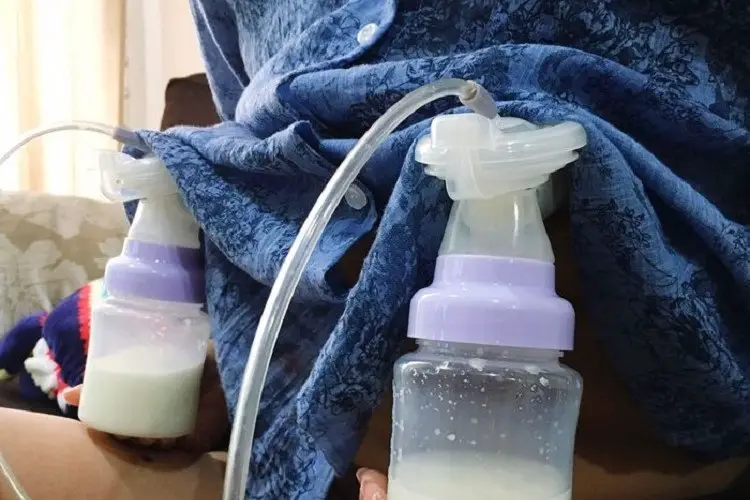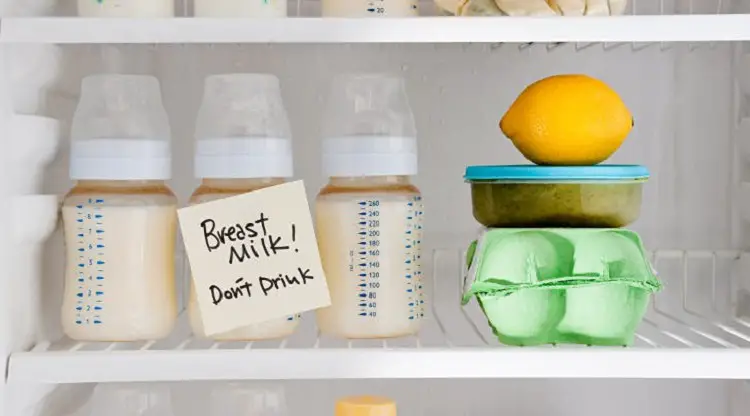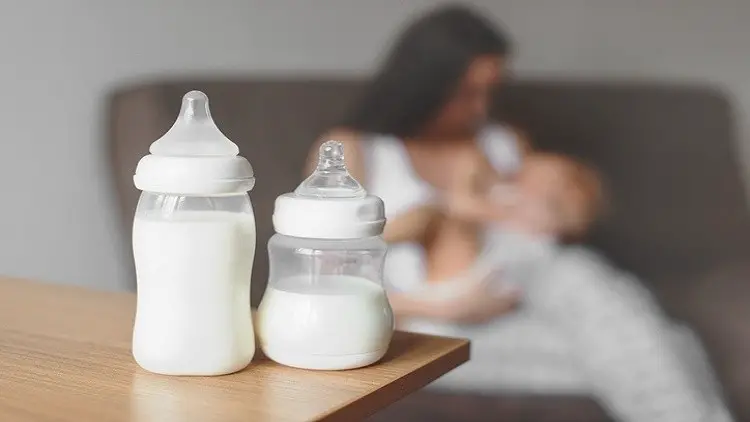Are you wondering how to store breast milk? Whether you’re going back to work, you want to have your partner help with feedings or want to make sure you have breast milk for your little one if you are away for a long time, you will need to pump and store your breast milk.
You can refrigerate your pumped (or expressed) breast milk properly by storing it in clean bottles with screw caps, hard plastic cups that have tight caps, or pre-sterilized nursing bags. Read on as we have tips for you on how to pump your breast milk and storing it safely.
How To Pump Breast Milk?

As a nursing mom, if you are unable to breastfeed your baby directly, ensure to pump during feeding hours. This will help you to continue making milk.
However, to get this properly done make sure you follow the guide below before pumping.
- Before you pump, wash your hands with mild soap and water.
- If you do not have soap and water, use an alcohol-based hand sanitizer that has at least 60% alcohol.
- Make sure the area where you are pumping and your pump parts and bottles are clean. You do not need to wash your breasts and nipples before pumping.
If you need suggestions on how to get your milk to start flowing without your baby there, you can:
- Try to imagine the things you love about your baby. Bring any baby stuff, blanket, or clothing that has your baby’s fragrance on it.
- Apply a warm, moist cloth to your breasts.
- Gently massage your breasts.
- Gently rub your nipples.
- Visualize the milk flowing down.
- Sit still and think of a relaxing setting.
Methods To Express Your Milk By Hand Or Pump
- Hand Expression: You can use your hand to squeeze and press on your breast to remove milk. This method is good if you are not often away from your baby or you need an alternative that is always with you. However, this method is free but requires practice and skill but it gets easier with practice and can also be as fast as pumping.
- Manual Pumping: You can use your hand and wrist to operate the device to pump milk. This method requires practice and skill as it may put you at higher risk of breast infection Manual pumping is good for occasional pumping if you are away from your baby once in a while and the device may cost about $30 to $50.
- Electric Breast Pump: This device runs on a battery or plugged in an electric outlet. This method will sound a lot easier for some moms as it can pump one breast at the same time. That is device collects more milk in less time, which is helpful if you are going to work or school full-time and may cost about $150 to $200 on Amazon.
Read Also: What To Do With An Old Breast Pump
How To Store Breast Milk Properly?

After Each Pumping:
- Make sure you keep milk at room temperature. Breast milk is good for up to 4 hours after pumping at room temperature (up to 77°F).
- Refrigerate milk. Breast milk can last ok in the refrigerator for up to 4 days.
- Place breast milk in the freezer if you’re not going to use refrigerated breast milk within 4 days after pumping. Freeze it right away after pumping.
- Use cooler packs. Place breast milk in a cooler or insulated cooler pack with ice packs for up to 24 hours after pumping. After 24 hours in a cooler take breast milk to the freezer to be refrigerated.
Note
When storing breast milk, use breastmilk storage bags, which are made for freezing human milk. Clean glass or hard BPA-free plastic bottles with tight-fitting lids can also do the job. Never use containers with the recycle number 7, which may contain BPA (Bisphenol A). Never use disposable bottle liners or other plastic bags to store breastmilk.
Read Also: Why Does My Breast Milk Taste Salty?
How To Store Breast Milk: Tips For Freezing Milk
It’s helpful to label each milk container with the date when the milk was expressed (and your baby’s name if the milk is going to childcare providers).
- Clearly label milk containers with the date the milk was expressed. Include your child’s name if you are giving the milk to a child care provider.
- Freeze breast milk in small quantities (2 to 4 ounces, or ¼ to ½ cups) for later or night feedings.
- Leave some space or inch from the milk to the top of the container, because it will get bigger when freezing.
- Wait to tighten bottle caps or lids until the milk is completely frozen.
- Store milk in the back of the freezer, not on the shelf of the freezer door to avoid thawing.
How To Store Breast Milk: Tips For Thawing And Warming Up Milk
- Thaw the oldest breastmilk first.
- Breastmilk does not need to be warmed. Some nursing mothers prefer to serve it at room temperature. Some mothers prefer to serve it cold.
- Thaw the bottle or bag of frozen milk by putting it in the freezer overnight.
- If you decide to warm the breastmilk, keep the container sealed while you warm. Then, hold it under warm, not hot, running water. Test the temperature of the milk by dropping some on your wrist before giving it to your baby. Remember, do not a bottle or bag of breastmilk in the microwave.
- After that, now swirl the breast milk to mix the fat, which might have separated. Do not shake the milk.
- Ensure you feed the baby the milk within 24 hours of thawing it in the refrigerator. That is 24 hrs from when the breastmilk is no longer frozen, and not from when you take it out of the refrigerator.
- Once breastmilk is thawed to room temperature after being in the refrigerator, you must use the milk before 2 hours. If you have any leftover milk when the baby is finished feeding, you can throw it out after 2 hours.
- Do not put breastmilk back in the fridge after it has been thawed.
Read Also: How To Store Formula Milk For Night Feeds?
How Long, Exactly, Can I Store Breast Milk For Healthy Full-Term Infants?
Countertop Or Table:
- You can store fresh breast milk on a table at room temperature for 6 to 8 hours (at no warmer than 77°F, or 25°C). Make sure containers are well covered and kept as cool as possible.
Refrigerator:
- You can store fresh breast milk in the back of the refrigerator for up to 5 days at 32°–39°F (0°–3.9°C).
Freezer: You can store fresh breast milk in the freezer. Just make sure to leave some space at the top of the container or bottle to allow for expansion of the milk when it freezes.
- It can be stored for up to 2 weeks in a freezer compartment located inside the refrigerator.
- Freshly breast milk can also stay up to 3 to 6 months in a self-contained freezer and connected on top of or on the side of the refrigerator and is kept at 0°F (–18°C). Also, make sure you store the milk in the back of the freezer, and not by the door.
- It can also be stored for 6 to 12 months in a deep freezer that’s always -4°F (–20°C)
Read Also: Why Your Thawed Breast Milk Looks Grainy
Why Does My Frozen Breast Milk Change Color? Is This Ok?
Yes, frozen or refrigerated breast milk may look a little different from fresh breast milk, but that doesn’t mean it’s bad for your baby. It’s normal for early breast milk to look kind of orange while the mature milk looks slightly blue, yellow, or brown when refrigerated or frozen.
This may separate into a creamy looking layer and a lighter, more milk-like layer. Just swirl it gently to mix it up again if this happens. The soapy smell or taste is due to the breakdown of fats in the milk.
Most babies won’t have a problem with it since the milk is still safe to drink. If your baby doesn’t like it, reheat the milk to scalding (bubbles around the edges) right after it is pumped or expressed and then quickly cooled and frozen. This switches off the enzymatic protein that breaks down the milk fats.
Read Also: How To Travel With Breast Milk
Conclusion
I hope this article has given an in-depth discussion to answer the question, how to store breast milk properly. However, having the right information will help take care of the baby properly, and also make your nursing experience an interesting and stress-free one.
Do you have any breast milk gone bad experience or extra tips on how to store breast milk? kindly share in the comment section below. Still want to learn more? Learn How To Relieve Sore Nipples Breastfeeding
